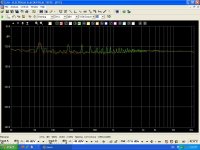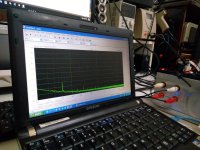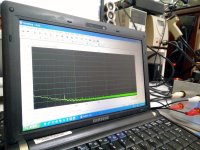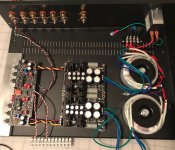I have to report, after I spend like month with AK4490_DCG3_GradoPS500, that this combo sounds really really really nice
I can listen them for hours no matter how Grado are uncomftroble
Thanks once again to Salas, Tea and Lyben
(one pic from office, I don't mind the heat...haven't drill holes like Algar did)
You are welcome. Best test is the test of time they say. Nice to know that you guys report back happy.
I have managed to repair them yet.
Although not my Beyerthday until next week a box arrived from Amazon and I have been allowed to unpack and have a listen to the DT150's which I think I am going to enjoy listening to. Thank very much for the advice.
DT150, I have those cans for about 7 years or more. Like many things about them.
Do you mean that all Chinese-made DACs are bad DACs?
No, that is not what I wrote. I wrote "cheap Chinese-made DACs", such as the dime-a-dozen DACs sold on Ebay that are based on decent DAC chips but the rest of the designs & components are objectively bad.
DT150, I have those cans for about 7 years or more. Like many things about them.
They accept the velour pads of the DT100 model also (part # EDT100 P). Then creating one of the flattest measuring set of cans ever. Some say they prefer them at most linear others say they prefer them as originally tuned.
Practical things for sure are, velour is much comfier than pleather and it breaths, also isolates less. Results to longer use time with much less sweat during summer but ultimately it lasts less as a material and needs a wash than just a wipe for when dirty.
Hi Salas. So here the latest results for the noise floor. As suggested I took my measurement with volume at mid-course, net effect was to see a higher 60Hz component, but reduced higher harmonics. Input is grounded.
Red trace is with case fully enclosed, Green trace is with volume pot ground pins connected to frame through a 10R resistor, it is slightly lower, but still is the better result ever I had. Now the noise floor is at -97dBV, instead of -95dB when I started.
Compare to your own measurement, I can see your using a laptop, probably running on battery. My own CLIO card is inside a PC, its power supply running off an insulated power transformer, so it is probably collecting nasty RF noise that reflects into my measurements. It is still one of the best results I had so far with my test setup.
Thanks for the tip.
Red trace is with case fully enclosed, Green trace is with volume pot ground pins connected to frame through a 10R resistor, it is slightly lower, but still is the better result ever I had. Now the noise floor is at -97dBV, instead of -95dB when I started.
Compare to your own measurement, I can see your using a laptop, probably running on battery. My own CLIO card is inside a PC, its power supply running off an insulated power transformer, so it is probably collecting nasty RF noise that reflects into my measurements. It is still one of the best results I had so far with my test setup.
Thanks for the tip.
Attachments
Last edited:
Now you added the pot's noise as a voltage divider's impedance hum pick up point. Which is representative of how we use the preamp. Integrated full audio band SNR number is one thing but your 60Hz hum band is very low at -114dBV. I did not understand if the green trace was also a closed case measurement again? Why you run a low 16384 FFT? Higher is better for noise. Also, select log than octave smoothing frequency axis mode if there is option. So to can see little spikes better.
Yes my take was better because the transformers were away from the metal frame located behind the DCSTB and the laptop was on battery but the power cables nearby on the bench were not that benign. The 50 Hz hum spike could easily jump to higher than yours if I wouldn't mains earth the preamp's test frame. See before and after clipping the earth lead pics. So your build has done very well for having mains wiring and big trafos crammed inside a single tight box.
Yes my take was better because the transformers were away from the metal frame located behind the DCSTB and the laptop was on battery but the power cables nearby on the bench were not that benign. The 50 Hz hum spike could easily jump to higher than yours if I wouldn't mains earth the preamp's test frame. See before and after clipping the earth lead pics. So your build has done very well for having mains wiring and big trafos crammed inside a single tight box.
Attachments
They accept the velour pads of the DT100 model also (part # EDT100 P). Then creating one of the flattest measuring set of cans ever. Some say they prefer them at most linear others say they prefer them as originally tuned.
Practical things for sure are, velour is much comfier than pleather and it breaths, also isolates less. Results to longer use time with much less sweat during summer but ultimately it lasts less as a material and needs a wash than just a wipe for when dirty.
Nice tip.
I'm always buying leather ones. My 3d set arrived just two weeks ago. Changing them every two years or so. It would be interseting to try velours.
Nice tip.
I'm always buying leather ones. My 3d set arrived just two weeks ago. Changing them every two years or so. It would be interseting to try velours.
Different pads swapping makes serious differences in the frequency response of all headphones. Sometimes irregular differences. But those velours make the DT150 not only softer and breathier to wear, they also linearize its response a lot. Depending on the genres of music preferred it may be a good thing or not. If listening to Reggae or EDM or watching movies you would probably prefer the bass boost of the vinyl pads for instance. Reminds of sizeable speakers in a room kind of bass. It does not bleed into masking the mids though. Anyway they will be nice to also have because they are an original Beyer inexpensive pair of pads that does things.
By the way I have done continuity tests in their input socket pins and it looks like that the signal returns are individual for the channels. The first pair of side by side pins across are + + second row are 0 0 last more spaced row are no connection possibly reserved for the side-mic version. Maybe we can all recall images of TV crew guys, especially studio cameramen, wearing elongated cup phones with a big pilot's like side-mic attached. Those were Beyers. So a "balanced" i.e. bridged drive cable can be possibly DIYed for them if needed when getting a spare connector.
I absolutely agree with Salas about pads. I followed some forum advice and upgraded my Monolith m1060 with Vegan Audeze made pads. I also installed felt made “phaser”. It is amazing how good they sound with my DCG3. These pads are bit pricy, but definitely worth $100 price tag.
You had to forcefully remove the old ones and use glue for the new? The Monoliths do not have removable pads provision if I remember correctly from their early reviews.
Arguably the most popular pads swap for a planar phone is putting Alcantara ones from Shure on the Fostex T50RP mk3 which has awfully uncomfortable original pads. To best keep the original sound though, its better to remove the back filters form those Shure pads (part# HPAEC1540). Unless a bit heavier than the original mk3 tone is actually preferred.
Arguably the most popular pads swap for a planar phone is putting Alcantara ones from Shure on the Fostex T50RP mk3 which has awfully uncomfortable original pads. To best keep the original sound though, its better to remove the back filters form those Shure pads (part# HPAEC1540). Unless a bit heavier than the original mk3 tone is actually preferred.
The nice thing about Audeze pads that they come with double side adhesive already pre-cut rings that perfectly match Monolith driver diameter. It was very easy to remove original pads and I also removed original adhesive. 2 min deal. I used that video as a guide, but I glued rings first and then fitted phaser.
YouTube
YouTube
I can say for sure that my AKG k701 is definitely show that 5k resonance particularly when I play some CDs and these also got that issue. Not that pronounced, but it was there. Nothing like that after upgrade. All frequency range is very smooth and they beat my Alf AKGs (Austria made) easily. Friend on mine has LCD-2 and after our tests I’m not sure which one I like more. For my humbled and subjective 50 years old ear they sound the same, pretty much. I think about cable upgrade too, but did not lock yet on wire that I’ll use.
So a "balanced" i.e. bridged drive cable can be possibly DIYed for them if needed when getting a spare connector.
Those Beyers are indeed a broadcasting and studio classic. Different models and impedances for different applications, but structurally it makes sense to build them the same.
Anyway, learned so many great things again here, Salas. Thank you. What would be the benefit of the "balanced" connector if for example integrating it to my future DCG3. A disadvantage would be that my headphones would suit the only device?

Its for when you build a doubled up balanced DCG3 because you want to use it in a source to power amp completely differential system, like a couple of members already did here, you can also drive cans floating between the phases. The voltage swing ability doubles. Its alike the bridged mono thing in sound reinforcement and car audio amps for extracting two channels power through a single output.
In the DT150's case it can only be down to you can also make a DIY cable if you will need compatibility to gear like some new DACs sporting four pin XLR "balanced" HP outputs too. Because its an easy 100mW max load. There is a widespread enough claim that any cans owe to sound better when connected between hot to hot. Expensive third party cables for the purpose are on offer for split channels return wiring able popular models like the HD650 etc.
The technical truth though is that when things are equal regarding needed swing ability and power reserve from classic SE hot to earth and "balanced" headphones drive, there can even be actual cons in the latter case.
Read this short article from a well known US studio gear company named Benchmark. Its covers the essentials about those modes of headphones driving: Audio Myth - Balanced Headphone Amplifiers are Better - Benchmark Media Systems, Inc.
In the DT150's case it can only be down to you can also make a DIY cable if you will need compatibility to gear like some new DACs sporting four pin XLR "balanced" HP outputs too. Because its an easy 100mW max load. There is a widespread enough claim that any cans owe to sound better when connected between hot to hot. Expensive third party cables for the purpose are on offer for split channels return wiring able popular models like the HD650 etc.
The technical truth though is that when things are equal regarding needed swing ability and power reserve from classic SE hot to earth and "balanced" headphones drive, there can even be actual cons in the latter case.
Read this short article from a well known US studio gear company named Benchmark. Its covers the essentials about those modes of headphones driving: Audio Myth - Balanced Headphone Amplifiers are Better - Benchmark Media Systems, Inc.
Hi everybody,
I’m getting there—slowly, but still having fun!
Here are my numbers so far.
DV voltage at dual mono PSUs, unloaded (sorry, forgot to write down loaded but I checked before installing the chip and they were couple tenths of a volt lower than unloaded).
+17.37Vdc
-17.47Vdc
+17.18Vdc
-17.30Vdc
Bias across R10(12R)s on DCG3 PCBs::
99.5mA
98.8mA
DC offset, inputs shorted, with opamp chip, fluctuating between:
-0.04 to -0.09mV
0 to +0.07mV
Do you guys think those numbers are good enough or should I do some tweaking?
I’m attaching a photo of my WIP setup so far. Once I put it all in the chassis, I’ll add an i-select board.
As always, I’m very grateful for all your helpful posts along the way.
Dan
I’m getting there—slowly, but still having fun!
Here are my numbers so far.
DV voltage at dual mono PSUs, unloaded (sorry, forgot to write down loaded but I checked before installing the chip and they were couple tenths of a volt lower than unloaded).
+17.37Vdc
-17.47Vdc
+17.18Vdc
-17.30Vdc
Bias across R10(12R)s on DCG3 PCBs::
99.5mA
98.8mA
DC offset, inputs shorted, with opamp chip, fluctuating between:
-0.04 to -0.09mV
0 to +0.07mV
Do you guys think those numbers are good enough or should I do some tweaking?
I’m attaching a photo of my WIP setup so far. Once I put it all in the chassis, I’ll add an i-select board.
As always, I’m very grateful for all your helpful posts along the way.
Dan
Attachments
Hi
Your numbers are really good. Check the heat for maybe opting for the high bias setting? Or for something in between with 9.1R or 10R? I see a big box.
One last thing out of curiosity, by watching that only the black DVM probe is used on ground pads, check the channels output offset polarity again.
Your numbers are really good. Check the heat for maybe opting for the high bias setting? Or for something in between with 9.1R or 10R? I see a big box.
One last thing out of curiosity, by watching that only the black DVM probe is used on ground pads, check the channels output offset polarity again.
- Home
- Source & Line
- Analog Line Level
- Salas DCG3 preamp (line & headphone)



